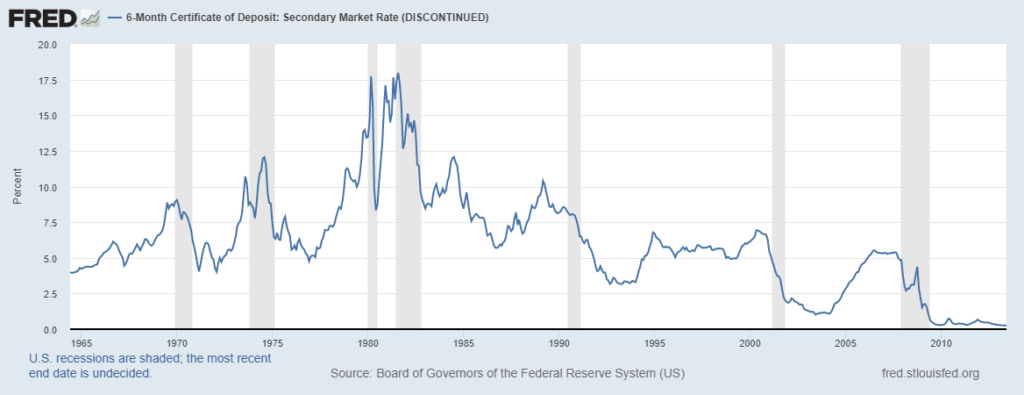By Paul Ohanian, CFP®
In the early days of my career as an investment professional, you could walk into your local bank and buy a 9% Certificate of Deposit. Today, that income staple is extinct. What was once a fairly cyclical pattern-Interest rates go up, interest rates go down-has steadily declined to flatline. And while low borrowing costs may have been a boon to many borrowers, it has become the bane of savers and retirees. This article discusses that decline and solutions we apply to “fill the gap.”
The chart below displays the long downward march of CD rates over the past 45 years:

For thoughtful investors, there are a variety of strategies and asset classes they and their advisors can engage to counteract this ongoing assault on savers. These include being invested broadly across the yield curve, utilizing defensive bond structures such as high-coupon callable bonds, and gaining exposure to a diversified mix of higher income/cash flow asset classes. These include “chicken equity” asset classes such as convertible bonds, high yield bonds, floating rate and bank loan securities, asset backed securities, and real assets including real property and REITs (Real Estate Investment Trusts). (I reference these as “chicken equity” because these high cash flow assets enable investors to retain some exposure to an improving economy without the same degree of stock market volatility, and with less interest rate risk than traditional plain vanilla bonds.)
Yields exceeding 4% and approaching 7%-8% can now be found in several of these less homogenous fixed income asset classes. The key is to find an advisor to partner with who is both adept at navigating the waters of these asset classes and discerning true value in each, and who has a depth of experience through several interest rate cycles and the necessary perspective needed to assemble genuinely diverse portfolios and achieve real risk reduction.
DISCLOSURES
Scottsdale Wealth Planning, Inc. (“SWP”) is a registered investment adviser. Advisory services are only offered to clients or prospective clients where SWP and its representatives are properly licensed or exempt from licensure.
The information provided is for educational and informational purposes only and does not constitute investment advice and it should not be relied on as such. It should not be considered a solicitation to buy or an offer to sell a security. It does not take into account any investor’s particular investment objectives, strategies, tax status or investment horizon. You should consult your attorney or tax advisor.
No investment strategy or risk management technique can guarantee returns or eliminate risk in any market environment. All investments include a risk of loss that clients should be prepared to bear. The principal risks of SWP strategies are disclosed in the publicly available Form ADV Part 2A.
Generally, among asset classes, stocks are more volatile than bonds or short-term instruments. Government bonds and corporate bonds have more moderate short-term price fluctuations than stocks, but provide lower potential long-term returns. U.S. Treasury Bills maintain a stable value if held to maturity, but returns are generally only slightly above the inflation rate.
Asset Allocation may be used in an effort to manage risk and enhance returns. It does not, however, guarantee a profit or protect against loss.
Issuers of convertible securities tend to be subordinate to other debt securities issues by the same issuer, may not be as financially strong as those issuing securities with higher credit ratings, and may be more vulnerable to changes in the economy. Other risks associated with convertible bond investments include: Call risk which is the risk that bond issuers may repay securities with higher coupon or interest rates before the security’s maturity date; liquidity risk which is the risk that certain types of investments may not be possible to sell the investment at any particular time or at an acceptable price; and investments in derivatives, which can be more sensitive to sudden fluctuations in interest rates or market prices, potential illiquidity of the markets, as well as potential loss of principal.
Investing in high yield fixed income securities, otherwise known as “junk bonds”, is considered speculative and involves greater risk of loss of principal and interest than investing in investment grade fixed income securities. These Lower-quality debt securities involve greater risk of default or price changes due to potential changes in the credit quality of the issuer.
Although bonds generally present less short-term risk and volatility risk than stocks, bonds contain interest rate risks; the risk of issuer default; issuer credit risk; liquidity risk; and inflation risk.
Investing in REITs involves certain distinct risks in addition to those risks associated with investing in the real estate industry in general. Equity REITs may be affected by changes in the value of the underlying property owned by the REITs, while mortgage REITs may be affected by the quality of credit extended. REITs are subject to heavy cash flow dependency, default by borrowers and self-liquidation. REITs, especially mortgage REITs, are also subject to interest rate risk (i.e., as interest rates rise, the value of the REIT may decline).